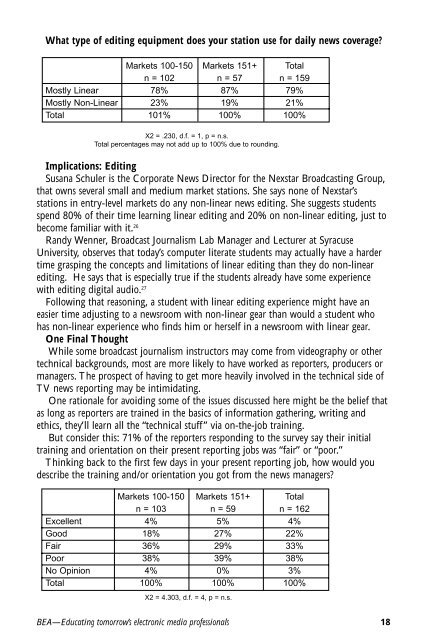JUNEFeedback
Issue 3 - Broadcast Education Association
Issue 3 - Broadcast Education Association
You also want an ePaper? Increase the reach of your titles
YUMPU automatically turns print PDFs into web optimized ePapers that Google loves.
What type of editing equipment does your station use for daily news coverage?Markets 100-150 Markets 151+ Totaln = 102 n = 57 n = 159Mostly Linear 78% 87% 79%Mostly Non-Linear 23% 19% 21%Total 101% 100% 100%X2 = .230, d.f. = 1, p = n.s.Total percentages may not add up to 100% due to rounding.Implications: EditingSusana Schuler is the Corporate News Director for the Nexstar Broadcasting Group,that owns several small and medium market stations. She says none of Nexstar’sstations in entry-level markets do any non-linear news editing. She suggests studentsspend 80% of their time learning linear editing and 20% on non-linear editing, just tobecome familiar with it. 26Randy Wenner, Broadcast Journalism Lab Manager and Lecturer at SyracuseUniversity, observes that today’s computer literate students may actually have a hardertime grasping the concepts and limitations of linear editing than they do non-linearediting. He says that is especially true if the students already have some experiencewith editing digital audio. 27Following that reasoning, a student with linear editing experience might have aneasier time adjusting to a newsroom with non-linear gear than would a student whohas non-linear experience who finds him or herself in a newsroom with linear gear.One Final ThoughtWhile some broadcast journalism instructors may come from videography or othertechnical backgrounds, most are more likely to have worked as reporters, producers ormanagers. The prospect of having to get more heavily involved in the technical side ofTV news reporting may be intimidating.One rationale for avoiding some of the issues discussed here might be the belief thatas long as reporters are trained in the basics of information gathering, writing andethics, they’ll learn all the “technical stuff” via on-the-job training.But consider this: 71% of the reporters responding to the survey say their initialtraining and orientation on their present reporting jobs was “fair” or “poor.”Thinking back to the first few days in your present reporting job, how would youdescribe the training and/or orientation you got from the news managers?Markets 100-150 Markets 151+ Totaln = 103 n = 59 n = 162Excellent 4% 5% 4%Good 18% 27% 22%Fair 36% 29% 33%Poor 38% 39% 38%No Opinion 4% 0% 3%Total 100% 100% 100%X2 = 4.303, d.f. = 4, p = n.s.BEA—Educating tomorrow’s electronic media professionals 18
















